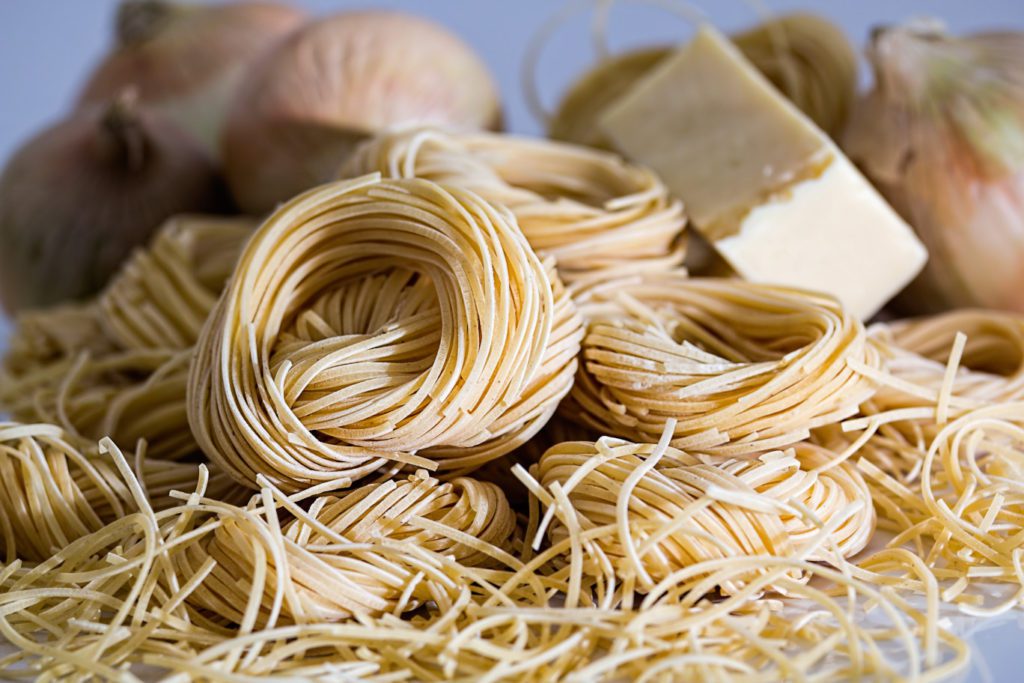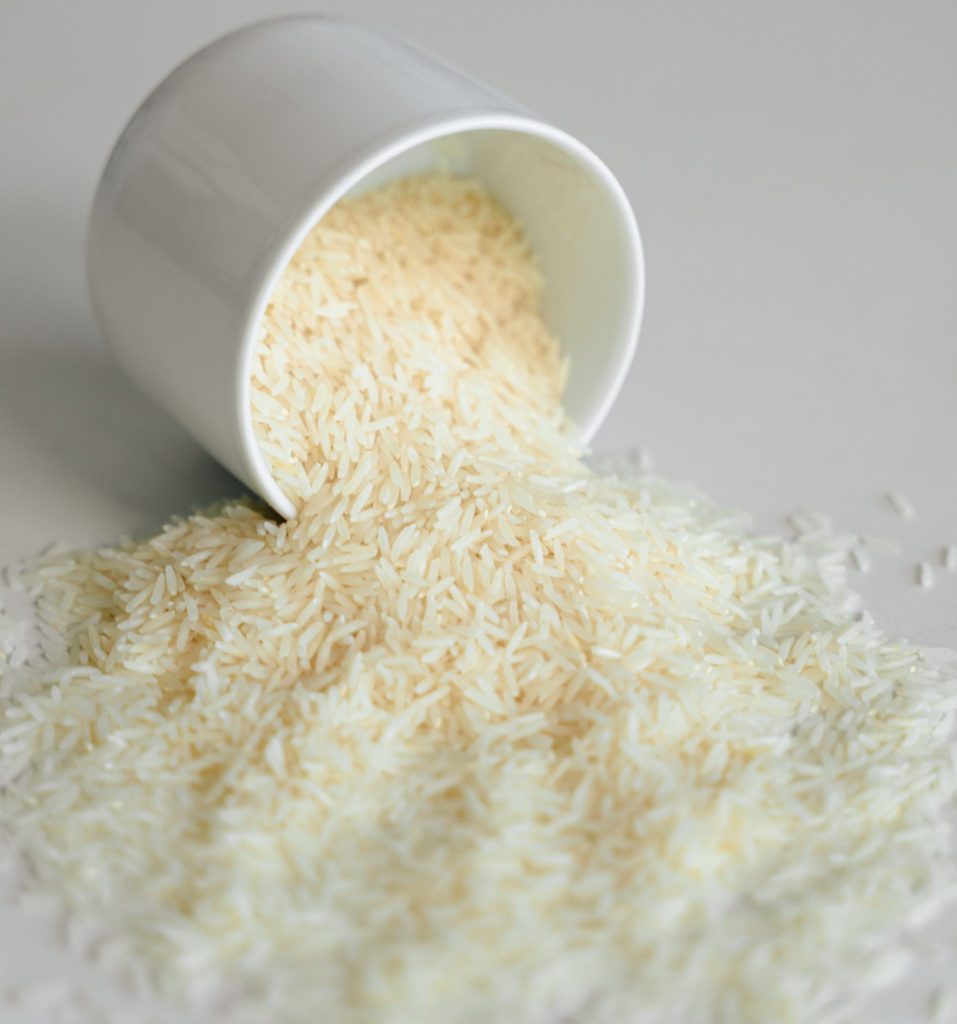Many prepper channels, blogs, and social media groups suggest an endless number of food items to keep on hand in case of emergency, also known as food staples. And while it’s nice to imagine shelves upon shelves of varied foods and supplies, the reality is we all must start somewhere! And even for the long-time preppers, the goal is usually to prepare as much as possible for as little time, space, and money as possible.
In this article, we want to give you a breakdown of the most efficient foods to keep in your disaster preparedness supply. We’ll be evaluating the food prepping staple categories by:
- Shelf life
- Storage
- Effort to prepare
- Cost (calories per dollar)
- Caloric density
- Nutritional value
Let’s get started…
White Rice and Pasta
Representing half of the classic all-star team for food preparedness, white rice and dry pasta check a lot of the boxes that make for an efficient, sustainable inventory. These items are extremely budget-friendly and are eaten regularly by most of the world’s population.
There’s also a good variety to be found – rice can be found in many varieties, including long, medium, and short-grain in the forms of arborio, basmati, jasmine, sticky, and more. Dry pasta can also be a relief from food fatigue, and while the flavor is generally the same, variety can be found in mixing up spaghetti, rotini, macaroni, shells, sheets, tubes, bowties, and more (although spaghetti and sheets are the most densely packaged).
Rice and pasta also allow endless variety as they add satiety and substance to endless soups and sauces – these are prepping staples for a reason!

Here’s how this item measures up with our criteria:
- Shelf life – According to a study by Utah State University, the shelf life of properly stored white rice is up to 30 years. (Note that brown rice retains the oily outer bran layer that makes it much less shelf-stable than white rice.)
- Storage – Rice and dry pasta can be stored in many different ways, including in food-safe plastic buckets, glass or plastic jars, or mylar bags. These items expand after being cooked, which means they store smaller than the food they actually provide.
- The effort to prepare – These items must be boiled, but only for a short time. They can be cooked a little at a time, making it possible to totally avoid waste.
- Cost – Based on prices monitored with our Prepper Deals service, rice currently clocks in at 700+ calories per dollar, which is quite a bit higher than many other food categories. Pasta averages within the 500-700 range, but can be as high as 1,200 calories per dollar, based on today’s prices.
- Calorie density – A five-gallon bucket of rice in a mylar bag contains approximately 36,000 calories, and a five-gallon bucket is approximately 1,140 cubic inches (assuming a couple of inches of headspace at the top), so caloric density is about 26 calories per cubic inch.
- Nutritional value – Rice and pasta are great for energy, as they are high in carbohydrates. Rice is also a good source of calcium, iron, thiamin, pantothenic acid, folate, and vitamin E (Source). Pasta also contains folic acid and is low in sodium and cholesterol, making it possible for those consuming it to control their intakes (Source).

Dry Beans / Legumes
Welcome the other half of the all-star prep food stash: dry beans and legumes. These team perfectly with rice and pasta, and are a powerhouse of nutrients while taking up minimal space.
This food category contains a massive variety, including black beans, black-eyed peas, garbanzo beans (chickpeas), northern beans, kidney beans, lentils, lima beans, pinto beans, split peas, and more.
Here’s how they measure up:
- Shelf life – Dry beans that have been packaged in #10 cans or mylar bags have a shelf life of 30 years – or more! It’s best to make sure they are stored without exposure to oxygen, heat, or light to achieve this.
- Storage – Dry beans don’t require any moisture or air to store, so they are extremely efficient. Beans expand when they absorb water, so this is a very efficient food to store dry. Beans are commonly stored in Mylar bags and five-gallon buckets, but can also be stored canned, which takes up quite a bit more space.
- The effort to prepare – Dry beans are one food you will need to really plan ahead to use in a meal. Dry beans must be picked through, soaked, and boiled. (Check out The Prepared’s guide to preparing dry beans.) Other legumes like lentils tend to cook up faster but still require some planning ahead. However, many beans and other legumes are available canned and could be eaten straight out of the can. If you have lots of space and are concerned about your ability to cook, canned beans could work for you.
- Cost – Assuming an average price of $2 per pound, dry beans currently clock in at about 500 calories per dollar, which is definitely a strong number compared with other food categories.
- Calorie density – Approximately 24 pounds of dry beans can be stored in a mylar bag and five-gallon bucket, with an average of around 25,000 calories total for that volume. Given that a five-gallon bucket is approximately 1,140 cubic inches (assuming a couple of inches of headspace at the top), caloric density is about 22 calories per cubic inch.
- Nutritional value – Dry beans are a nutritional powerhouse, packing the highest protein of any plant source. They contain almost all the amino acids, as well as fiber, starch, and several minerals and vitamins.
Canned Fruits and Vegetables
Another basic item your inventory needs is vitamin-carrying fruits and vegetables. These can have quite a long shelf life if stored properly and can introduce endless variety into your prep supply. Tomatoes, peaches, pickles, and many other potential ingredients can be stored in this way, and are important for any well-rounded supply.
Take a look at how they fit our criteria:
- Shelf life – According to HealthyCanning.com, you should plan for your home-canned foods to expire after about one year. In a perfect canning situation, food would likely last much longer than that, but it’s not a guarantee. Professionally canned food can last much longer.
- Storage – Canned fruits and vegetables are easy to stack, store, and inventory. If you are prepping in a very small space, consider whether canned foods are a better choice than dehydrated foods. However, canned foods pack a double punch of both nutrition and hydration, as they will contain water.
- Effort to prepare – These are the most convenient to consume, as many of these can be consumed straight out of the can or jar and don’t even need to be cooked. If you are concerned about a power failure or no ability to cook food, make sure your canned food supply is in good shape.
- Cost – Since this is such a broad category, it’s impossible to provide averages that would be meaningful. However, upon reviewing the calories per dollar of products in this category, according to our Prepper Deals service, canned corn is by far the most cost-efficient canned vegetable to prep (at up to 400+ calories per dollar), and canned fruit in syrup looks to be about 150-200 calories per dollar.
- Calorie density – Again, being such a broad category, it’s not possible to provide guidance here. In the future, we plan to enhance the Prepper Deals service to provide this information live, right on the deals page.
- Nutritional value – Many, many fruits and vegetables can be canned, which means the foods you select for your supply can provide you with a multitude of various vitamins and minerals. This is also a great place to make sure to stock up on foods your family likes, and that will help avoid food fatigue.
Conclusion
A thorough and varied prep inventory will have many more foods in it than the three listed here, but these are the most important to start with. When building your supply, considering these factors is crucial, and the more you do it, the better you will get at it.




I think you nailed it. Don’t forget to have many spice to use for those beans and rice so that they don’t always taste the same.
I totally agree Marie! A variety of spices will help to avoid food fatigue.
Thanks for the comment!
Good, well written article and I completely agree. I also suggest that when you are looking to store food of any kind, pick what you would normally eat…and concentrate on picking the most nutrient dense foods that you like. You are going to need the vitamins. And your blog page is very well designed!
Great points Gail! And thanks, I’m glad you like the design :)
Very good explanations…thorough. Thanks.
You’re welcome! Thanks for being here :)
I have quite a few buckets of both jasmine and basmati rice and found a good deal on some medium grain white rice that I’m going to be grabbing enough for at least a couple buckets to have for making furkid foods. I do need to add a lot more pasta to my preps to even things out a bit. Couscous is another staple I can’t go without. I’ve lost count as to how many cases of the several kinds of canned beans I have . I have far more cans than dried right now simply for ease and convenience because the initial shock will be very stressful and I believe having healthy foods that can be simply thrown together for family meals (at least in the beginning) will allow everyone the ability to take a breath, process their current situation and then work into the other things that take more planning and time.
I agree Julie, the convenience of the canned beans is a great reason to have some percentage of your beans in that form. The cost is higher, but I agree with your thinking about the stress of a potential disaster situation and being able to serve meals without much preparation could be really helpful.
Thanks for the comment!
Good description of the staples. And, I agree you want some variety (and spices). Being in a place with water, dehydrated and self freeze-dried food can help. I did want to note one thing.
When it comes to white rice, there are two types — polished and parboiled rice. With polished rice, the newer way, abrasives are used to scrape off all the bran of the rice and any vitamins or minerals there.
I think that polished rice is all carbs so I am not sure where the amino acids towards that complete protein are coming from.
The other way uses soaking and steaming to remove the bran (and the oils) and retains most of the vitamins and minerals (there is not a lot, but every bit can count). Uncle Ben’s is parboiled rice. The storage time for both types of rice are the same 30+ years.
The asian cultures consider polished rice better because it is really white and “the new way”. That is “special” rice. Parboiled rice is usually a little yellower and healthier, and is more the day-to-day rice. I do try to store mostly parboiled rice.
Hi Brian! Thanks so much for the additional information. It will be helpful for others reading this!
Thanks for these great ideas and tips.
You’re welcome!
Mike, dry beans can be pressure cooked without pre-soaking them. Also, if you are discussing pantry staples, I suggest you also include powdered milk, honey and/or sugar, and cooking oils.
Thanks Mary! Great to see you here :)
I’m curious, do you blog, or have you ever considered doing so?
?? Thanks Mike!!
Hi MammyK :) Thanks for checking out the blog!
Good information and thank you. I have found it easy to purchase Health Ranger Buckets and My Patriot Supply Buckets. The H.R. ones are organic and the M.P.S ones are dense with calories and include pre-made meals. Both companies buckets stack nicely. This way, I don’t have a bunch of different sizes of containers to manage. Still loving your app!!
Hi Shawn, thanks for the comment! I haven’t tried Health Ranger or My Patriot Supply buckets. I’ve mostly avoiding food buckets because I’ve heard the quality is disappointing, if / when it’s actually needed. Please let me know what you think and if I’m mistaken, maybe I’ll buy some and try it out.
This post was very informative about being prepared.
Glad you found it helpful Buddy! Thanks for the comment!
Good article Mike.
When I started, it was a mad dash to find out everything at once. Unfortunately, I made costly mistakes.
I didn’t know what I didn’t know.
It was awful, because I got so much bad advice! Trial, error, countless hours, more cost and more error- all so unnecessary. So much bad information out there. Saw one guy (with waaay too many subscribers) bragging about his storage containers. He was showing how he just bought and stacked. No mylar or 02 absorbers, nothing. There are many good voices, but filtering thru isn’t going to be fun for newbies. Thanks for stepping up!
Totally agree. That’s a big reason why I’m doing what I’m doing – to provide actionable, non-emotional guidance and tools for those who haven’t been prepping for decades.
Thanks for being here and for your comment!
Thank you for the information and for all that you do
It’s my pleasure Sheila. I’m happy to hear any ideas or requests for future blog post topics :)
Stocking up a lot lately and checking the shelf life.
That’s great Cassandra. Thanks for being here and for the comment!
Lots of good Information. Thanks for sharing.
You’re welcome. Glad to know it’s helpful for you!
I try to keep all these items in my pantry! They keep a long time and you never know when you may need them,
Absolutely!
This is great info!
Glad to hear it’s helpful Bradley!
Great read and very informative! Thank you!
You’re welcome! I’d love to hear any requests / ideas for blog post topics :)
Great information. Thanks.
My pleasure Josh
I think it is a great idea bc you’ll never know when there will be an emergency. Also it’s good to have stocks of certain items, that way you won’t run out & you have what you need and don’t need/have. Very informative! ??
Glad to hear the post was helpful Mia!
I always have pasta and beans around
Great options!
Been meaning to do this
There’s no time like the present :)
Canned fruits are my favorite meal prep gems! The juice they’re stored in is a kids’ favorite!
Nice!
Thanks so much for all this great info..
You’re welcome Brandon! Thanks for checking out the blog.
great info!
Glad it was helpful Bradley!
interesting article. i love rice
Glad to hear it was helpful. I love rice too, but I’m on a keto diet. But I won’t be on keto if SHTF!
i have rice i got great deals on ,but no nearly enough to last in an event longer tgan 2 months,i need bag beans & do have plenty can beans as well,need more can fruits as well.ty for the advice,learnig so much new to this so very exciting & interesting to read your post and learn,thank u
You’re very welcome Jeanette! Thanks for the comment!